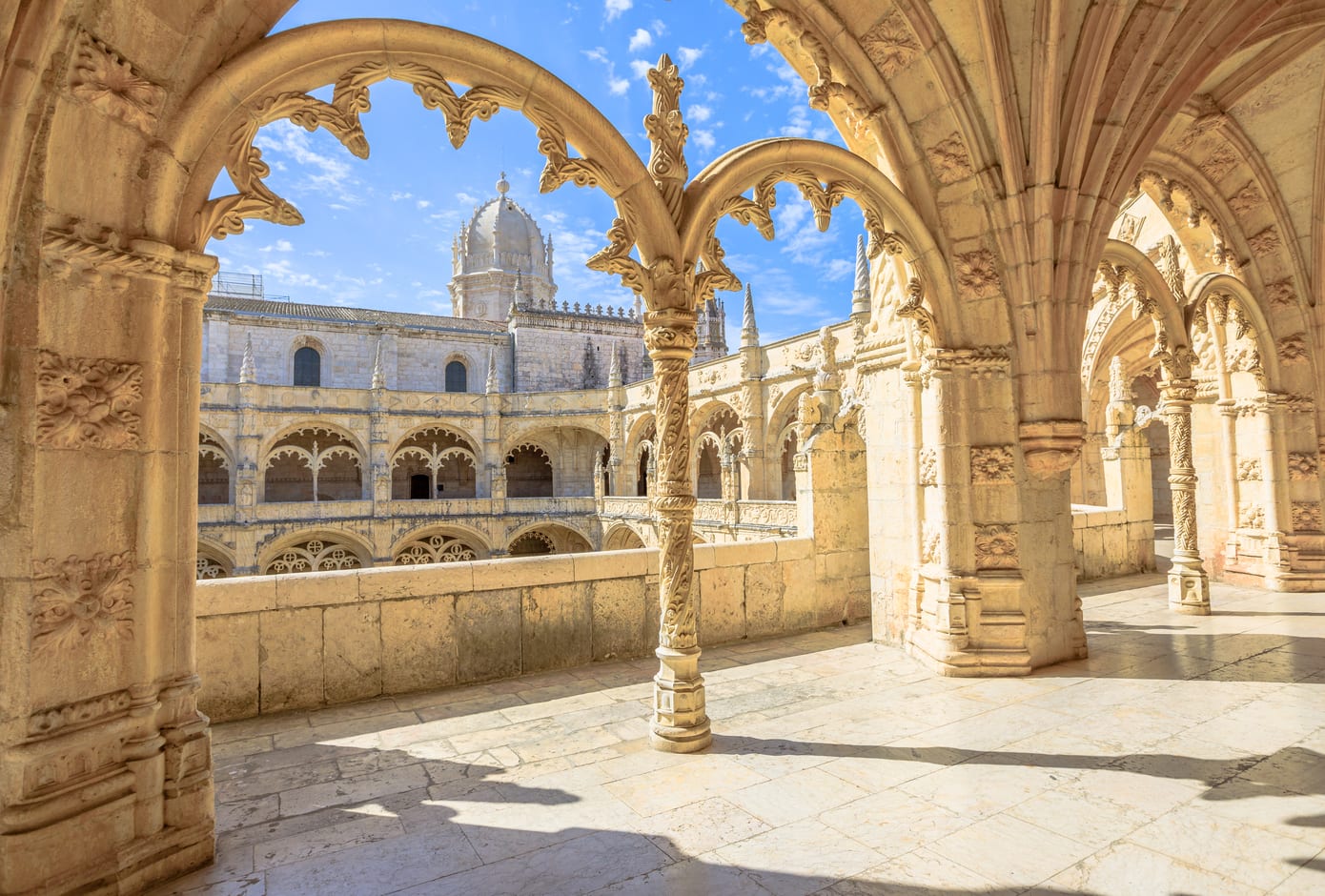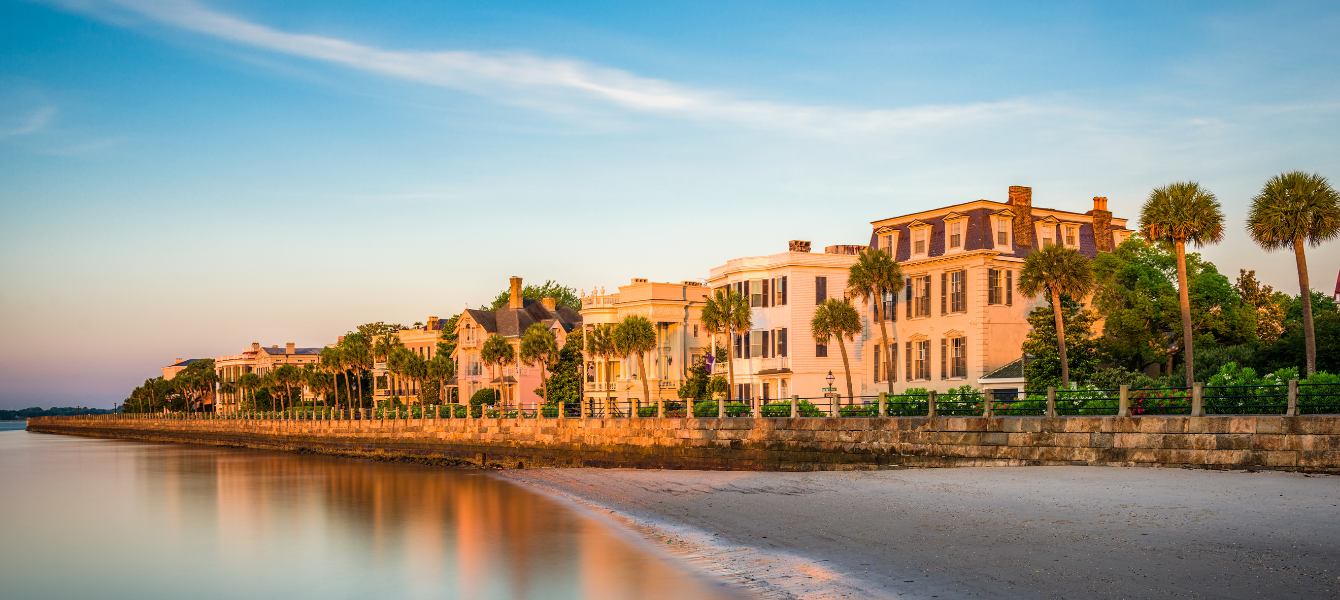Believe it or not, Portugal is more than a welcoming retreat for foodies and wine lovers. With a rich history that started around 400,000 years ago, the country is adorned with monuments and landmarks, and it’s home to 17 alluring UNESCO World Heritage Sites Portugal, from North to South.
Between one pastel de nata and another, why not take some time to visit the wide collection of landmarks that immortalize the history of the country? Portugal happens to be one of the top destinations in Europe for a culture-filled trip, so you’ll have plenty to see during your vacation.
We probably left you itching to uncover Portugal’s scenic — and utterly Instagrammable — landmarks. So, say no more. To help you plan, here’s the complete list of the 17 Portugal UNESCO World Heritage Sites. All of them are worth visiting and guaranteed to take you on a journey throughout the centuries. Spoiler alert: the Alto Douro Wine Region is included!
Quick Jumplinks
- Portugal UNESCO Sites
- UNESCO World Heritage Sites in Portugal: The Complete List
- Central Zone of the Town of Angra do Heroísmo, Azores Archipelago (1983)
- Convent of Christ, Tomar (1983)
- Monastery of Batalha, Batalha (1983)
- Monastery of the Hieronymites and Tower of Belém, Lisbon (1983)
- Historic Center of Évora (1986)
- Monastery of Alcobaça (1989)
- Cultural Landscape of Sintra (1995)
- Historic Centre of Oporto, Luiz I Bridge and Monastery of Serra do Pilar (1996)
- Prehistoric Rock Art Sites in the Côa Valley and Siega Verde (1998,2010)
- Laurissilva of Madeira (1999)
- Historic Centre of Guimarães (2001)
- Alto Douro Wine Region (2001)
- The Landscape Of The Pico Island Vineyard Culture, Azores (2004)
- Garrison Border Town of Elvas and its Fortifications (2012)
- University of Coimbra – Alta and Sofia (2013)
- Royal Building of Mafra – Palace, Basilica, Convent, Cerco Garden and Hunting Park (2019)
- Sanctuary of Bom Jesus do Monte, Braga (2019)
- Frequent Asked Questions
Portugal UNESCO Sites
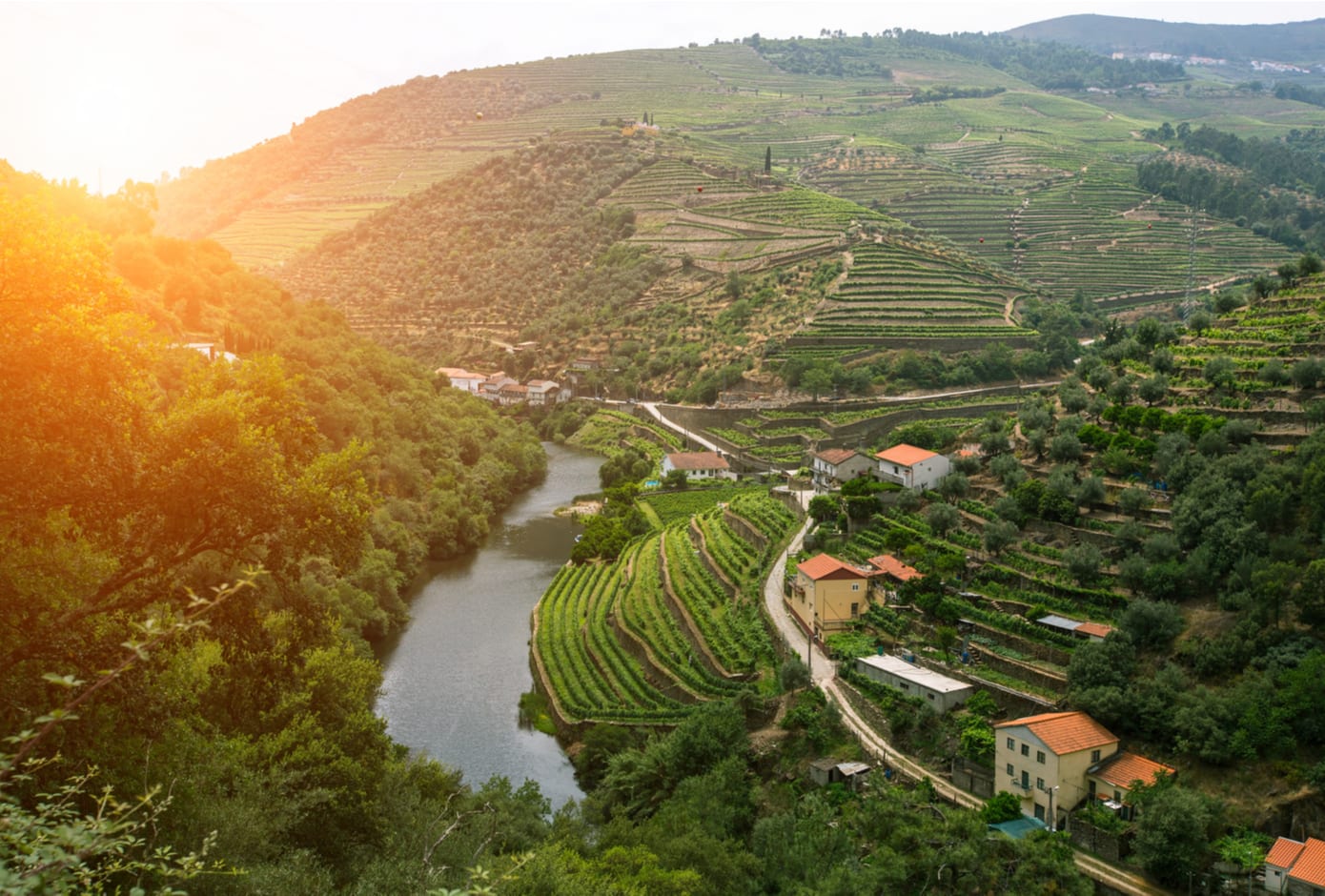
The UNESCO World Heritage Portugal currently lists 1,092 sites in 167 countries around the world. In Portugal, there are 17 World Heritage Sites, 16 of which are cultural sites and 1 is a natural site (the Alto Douro Wine Region).
The newest additions to the UNESCO World Heritage Sites in Portugal are The Royal Convent, in Mafra, the Sanctuary of Bom Jesus, in Braga, and the Machado de Castro National Museum, in Coimbra, which became World Heritage Sites in 2019. This was considered a reason for “great joy for all Portuguese”, said Marcelo Rebelo de Sousa, president of Portugal, as reported by Portugal News.
UNESCO World Heritage Sites in Portugal: The Complete List
Central Zone of the Town of Angra do Heroísmo, Azores Archipelago (1983)
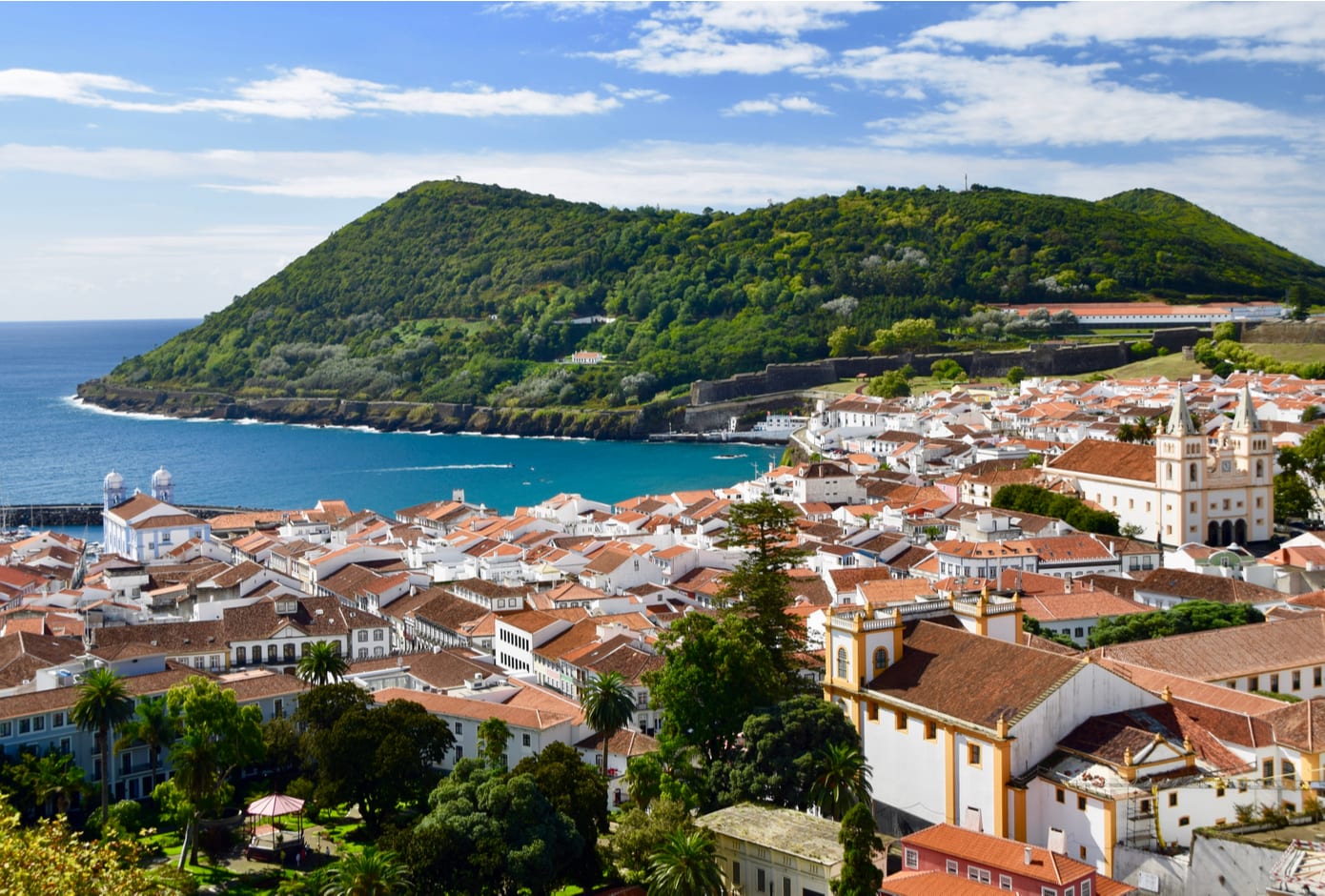
KEY INFO
| 📍 Address | Angra do Heroísmo, Terceira Island, Azores, Get Directions |
| 🚉 Getting There | Fly from Ponta Delgada to Terceira. |
| 🤑 Ticket Price | Free to visit |
| 🧭 Suggested Stay | 2-3 days |
Angra do Heroismo is a city located on Terceira Island — one of the 9 Azores islands— and, thanks to its significant maritime function, it was listed as a UNESCO World Heritage Site in 1983. Occupying a strategic positioning in the Atlantic Ocean, Angra was an obligatory port of call from the 15th century until the 19th century, aside from being the most important city in the archipelago. The city also happened to be the capital of Portugal during the Liberal Wars (1828 to 1834), and the seat of the Bishop of the Azores.
The historic center of Angra is definitely one of the most fascinating parts of the city, as it was able to maintain its authentic Renaissance urban design, and its 15th and 16th-century road network, even after the 1980 earthquake. Angra also boasts a showcase of Baroque-style religious buildings, including the cathedral of Santíssimo Salvador da Sé, the churches of the Misericórdia and Espírito Santo, and the convents of the Franciscans and the Jesuits.
Other must-see constructions in the historic center of Angra do Heroísmo are the 400-year-old San Sebastião and San João Baptista fortifications, which are unique examples of military architecture.
Find Hotels in Azores, Portugal
Convent of Christ, Tomar (1983)
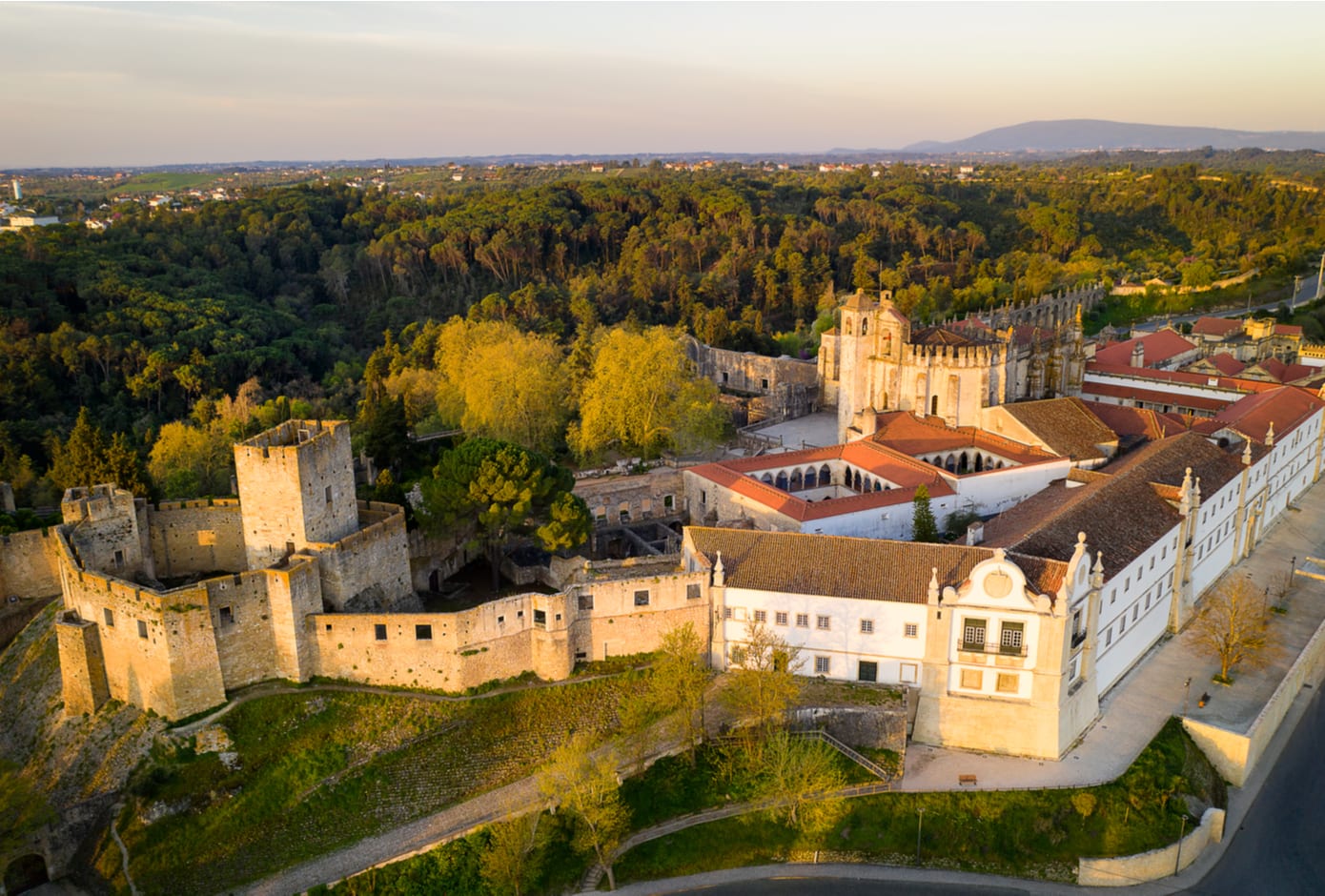
KEY INFO
| 📍 Address | Convento de Cristo, Igreja de Santa Maria dos Olivais, 2300-000 Tomar, Get Directions |
| 🚉 Getting There | Take the Train From Lisbon and Tomar via Entroncamento. |
| 🕗 Opening Hours | From 9 am until 5:30 pm |
| 🤑 Ticket Price | €6 per person |
| 🧭 Suggested Duration | 2-3 hours |
Located in the city of Tomar, in Portugal’s central region, the Convent of Christ is part of one of the largest Portuguese monument complexes, whose buildings and rural domains spread within roughly 45 acres. The convent is encompassed by the Castle of Tomar, which was founded by the Templar Knights in 1160, alongside with the Tomar village, on a site that was formerly used for Roman worship.
We recommend visiting the convent at length in order to uncover its unique details. Built over the span of five centuries, and sitting at the top of a hill, the Convent of Christ displays a range of architectural styles, from Byzantine-Romanic and Italian Renaissance, to Gothic and Manueline. The centerpiece — and one of the most fascinating sections of the convent— is the 12th-century Charola (Rotunda), which was the Knight´s private oratorium within the fortress. During your visit, also make sure to explore the Chapter House, whose ornamented windows are one of the finest samples of the Manueline style.
While the Convent of Christ is the main feature of Tomar, also take some time to wander around this quaint little city. Placed on the banks of Nabão River, Tomar is home to a medieval urban area with cobblestoned streets, aside from well-preserved constructions that immortalize Portugal’s history.
Find Hotels in Tomar, Portugal
Monastery of Batalha, Batalha (1983)
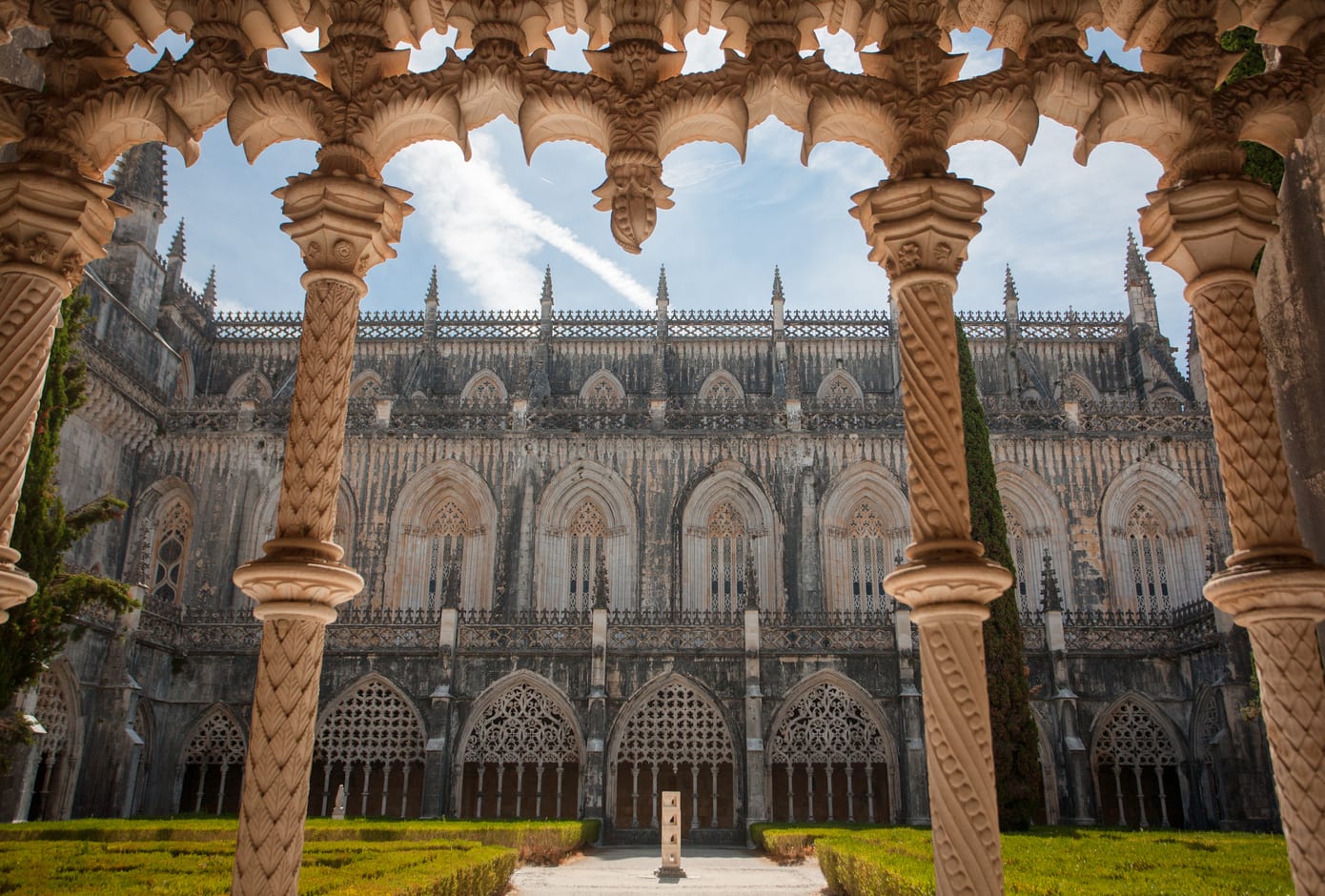
KEY INFO
| 📍 Address | Largo Infante Dom Henrique, 2440-109 Batalha, Get Directions |
| 🚉 Getting There | Take the Train From Estação Rodoviária de Sete Rios to Batalha Monastery. |
| 🕗 Opening Hours | From 9 am until 6:30 pm |
| 🤑 Ticket Price | €10 per person |
| 🧭 Suggested Duration | 2 hours |
Welcome to one of the finest samples of Gothic architecture in Europe. Monastery of Santa Maria da Vitória, or Monastery of Batalha, was built in fulfillment of a vow by King João to celebrate the victory of the Portuguese over the Castilians at the battle of Aljubarrota, in 1385.
Located in the city of Batalha, in central Portugal, the Monastery of Batalha is a sight to be seen by architecture and art lovers. This Dominican monastery designed by the English architect Master Huguet boasts a profusion of sculptures, which represent the 12 apostles, numerous Saints, prophets, angels, and biblical figures.
The monastery was built between 1388 and 1433 and finally completed during the reign of King Duarte I. Its interior, which is 80 meters long and 32.5 meters high, is dotted with rose stained-glass windows, and it’s home to a Royal Cloister. This, by the way, happens to be one of the most important features of the monument, as it harbors the medieval tomb of Dom João I and his wife, Queen Philippa of Lancaster.
Find Hotels Near Batalha, Portugal
Monastery of the Hieronymites and Tower of Belém, Lisbon (1983)
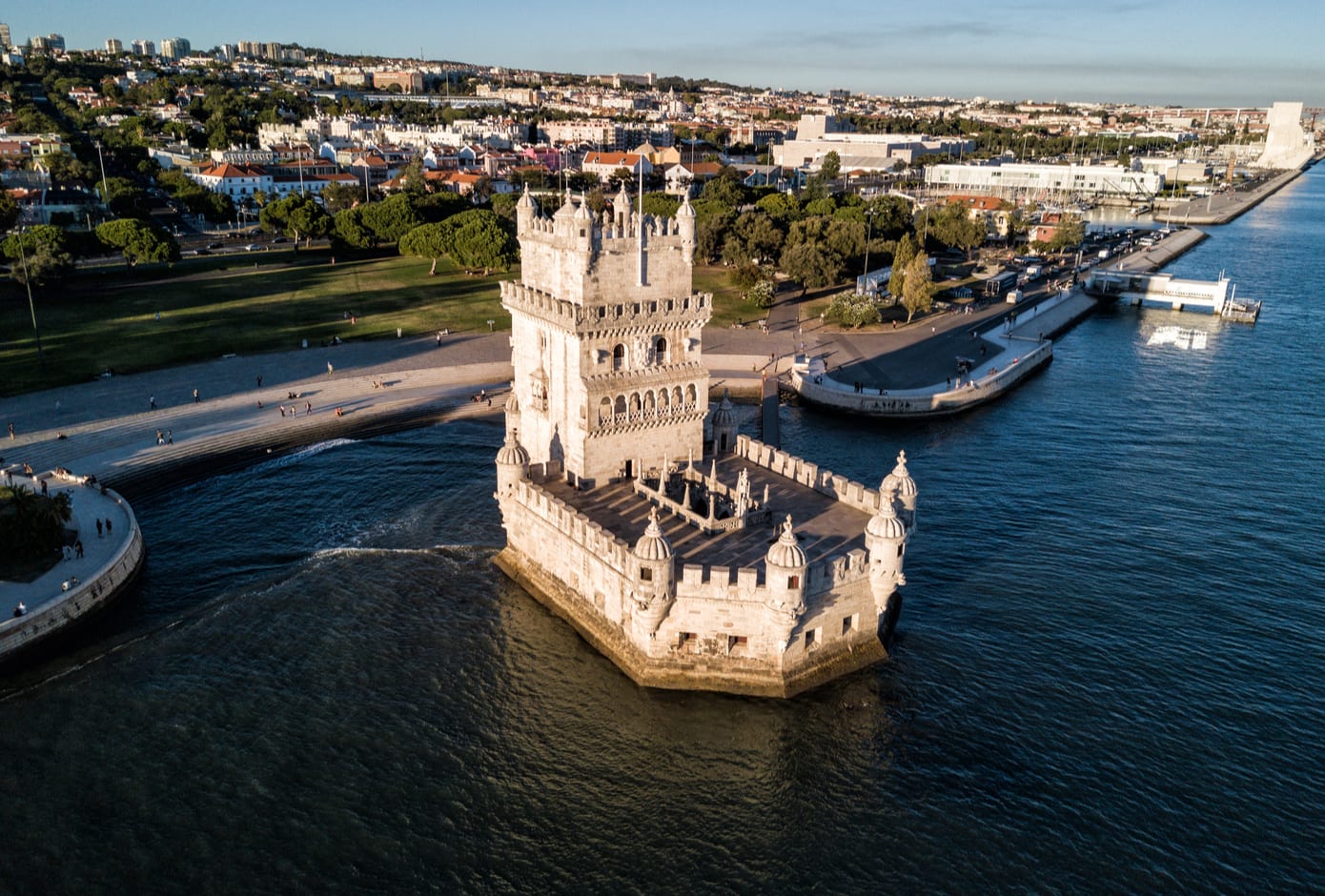
KEY INFO
| 📍 Address | Praça do Império, 1400-206 Lisboa, Get Directions |
| 🚉 Getting There | Take: Tram: line 15. Bus: lines 727, 28, 729, 714 and 751. Train: Belem, Cascáis Line. Boat: Belem Ferry Terminal |
| 🕗 Opening Hours | From 10 am to 6:30 pm., Monday: closed |
| 🤑 Ticket Price | €10 per person |
| 🧭 Suggested Duration | 1-2 hours |
The Jerónimos Monastery (Monastery of the Hieronymites) and the Tower of Belém are two historical gems placed in the very city of Lisbon. Commissioned by King D. Manuel I and gifted to the monks of Saint Hieronymus so they would pray for the king, the monastery is linked to the Age of Discoveries, as it was also built to perpetuate the memory of Prince Henry the Navigator. The monastery preserves a breathtaking and ornamented structure, typical of Manueline art, and it’s home to a two-story cloister built in the 16th-century.
Within a walking distance from the monastery and overlooking the Tagus River sits the Tower of Belém, one of the most prominent examples of Portuguese power during the Age of Discoveries. Erected between 1514 and 1520, this Manueline-style tower was designed by architect and sculptor Francisco de Arruda, and was strategically positioned to defend the city against attackers.
A quick tip: the perfect way to end your tour is by going to Pasteis de Belém, a traditional bakery cafe that has been making the famous Belém custard tarts since 1837.
Find Hotels in Lisbon, Portugal | Find Homes in Lisbon, Portugal
Historic Center of Évora (1986)
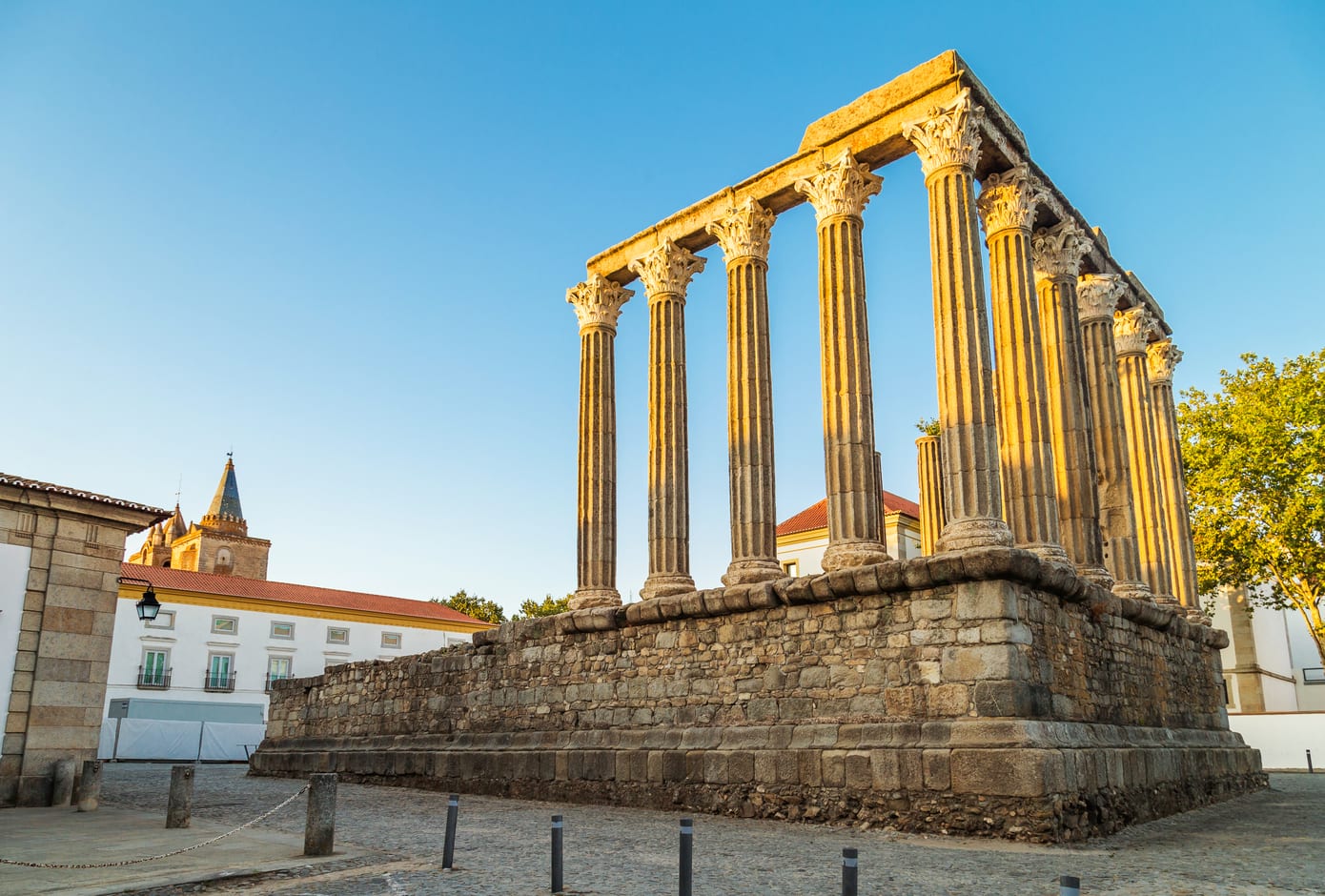
KEY INFO
| 📍 Address | Historic Center of Évora, Évora, Get Directions |
| 🚉 Getting There | Take the Bus from Lisbon to Évora, departing from Sete Rios bus station. |
| 🤑 Ticket Price | Free to visit |
| 🧭 Suggested Duration | Full day |
In the heart of the south-central Alentejo lies Évora. The city boasts a rich history that dates back to the Roman domination when it was an important town praised for its abundance of wheat and silver. In fact, until the present day, there are remnants of the Roman occupation in Évora, including the Temple of Diana, which is believed to have been built around the first century A.D.
Over the centuries, Évora was also ruled by the Moors, the Visigoths, and played an important position in the Portuguese reign during the Middle Ages, serving as the home of King João III.
The city center is compact and easy to explore on foot. You can start on Praça do Giraldo, an ancient market during the Moorish period and now the city’s main square, and head to the Roman Temple of Diana. Then, visit the Évora Museum, and the Sé de Évora, which is the biggest cathedral in Portugal. If you have time, go to the Chaple of Bones, located next to the entrance of the Church of St.Francis. The chapel, which is one of the best-known monuments in Évora, was built by Franciscan monks in the late 16th century, and it’s entirely conveyed by bones and skulls.
Find Hotels in Evora, Portugal
Monastery of Alcobaça (1989)
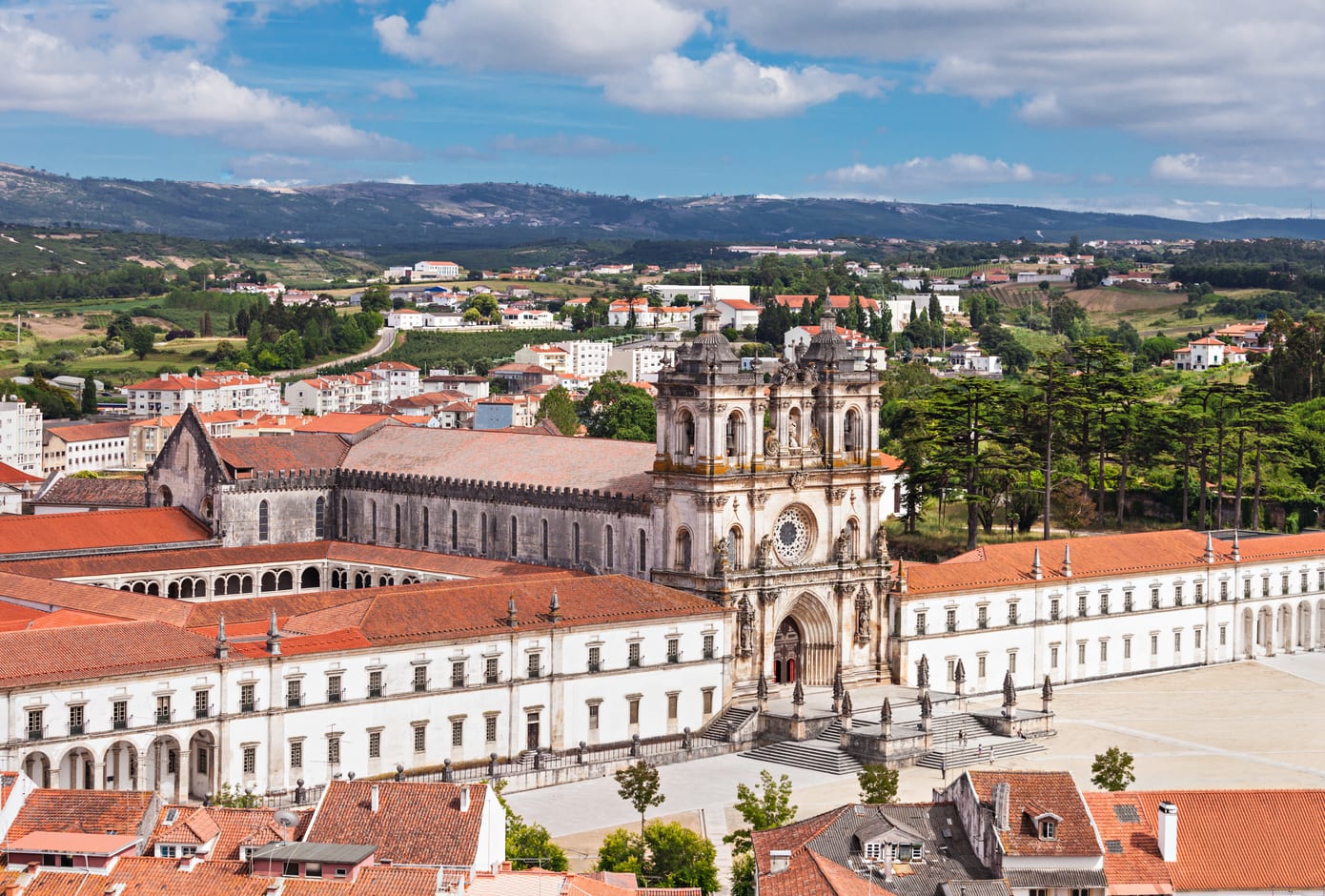
KEY INFO
| 📍 Address | Praca 25 de Abril, 2460-018, Alcobaça, Get Directions |
| 🚉 Getting There | Take the bus from Lisbon Sete Rios to Alcobaça Monastery. |
| 🕗 Opening Hours | From 9:00 am to 7:00 pm (last entrance at 6:30 pm) |
| 🤑 Ticket Price | €6 |
| 🧭 Suggested Duration | 1-2 hours |
The Monastery of Alcobaça was founded in the 12th-century by King Afonso I as a gift to a Cistercian monk, Bernard of Clairvaux (Saint Bernard), after Portugal’s conquest of Santarém from the Moors, in 1152. Set in a rich and fertile land, the monastery was actually built only 25 years later, in 1178, and its layout was designed to evoke the abbey of Claraval, the Cisternian’s Order’s mother church in France.
Within the monastery sits a stunning church that is considered the largest Gothic religious structure in Portugal. Its interior, which is more than 20 meters high, is crossed by an imponent central nave, and it features a transept that houses the twin tombs of King Pedro and Inês de Castro. The Monastery of Alcobaça also plays host to 13th and 14th centuries Chapter House, a Refectory, Monk’s Rooms and Dormitory, and the Cloister of Silence, commissioned by King Dinis in 1382, and the largest medieval cloister in Portugal.
Find Hotels in Alcobaça, Portugal
Cultural Landscape of Sintra (1995)
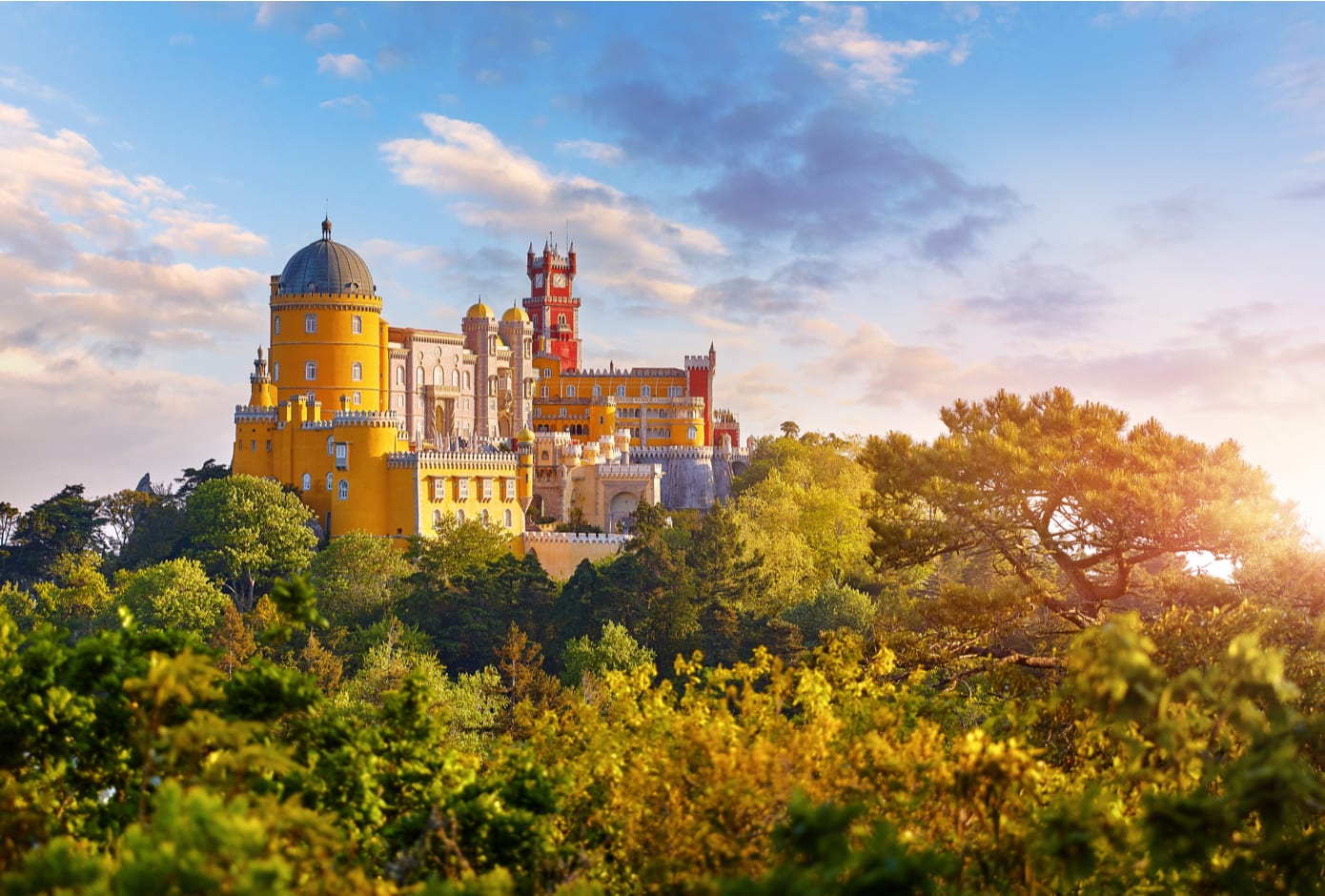
KEY INFO
| 📍 Address | Praca 25 de Abril, 2460-018, Alcobaça, Get Directions |
| 🚉 Getting There | Take the train from Lisbon’s Oriente, Rossio, or Entrecampos stations to Sinatra. Station |
| 🧭 Suggested Stay | 1-3 days |
Sintra might be a famous day-trip destination for those who visit Lisbon, but this quaint little village has enough sights to keep travelers busy for an entire week.
With immense natural beauty, this picturesque village is covered in both Mediterranean and northern European flora and encompasses the Sintra-Cascais Nature Park and the 10-kilometers long Sintra Mountains, which has been linked to prehistoric astral cults. This lush vegetation perfectly frames Sintra’s cultural sites, including the National Palace of Pena, the city’s most prominent feature. Placed at the top of a hill, in the Sintra Mountains, this colorful palace is believed to have been built on the site of the Moorish alcazar of Sintra, and it displays the largest collection of Hispanic-Moorish tiles in Europe.
In the 15th-century, Sintra became a famed summer retreat for the affluent people in Portugal, and later on, during the 19th-century, Sintra became the first center of European Romantic architecture. Dating from this period are the Pena Palace, the Monserrate Palace, and Quinta da Regaleira, among others.
When exploring this picturesque cultural landscape of Sintra, don’t forget to stop by Casa Piriquita. Founded more than 150 years ago, the bake is particularly famous for protruding the famous “travesseiros de Sintra” (en: Sintra’s Pillows), a dessert made of puff pastry with a filling of almond cream.
Find Hotels in Sintra, Portugal | Find Homes in Sintra, Portugal
Historic Centre of Oporto, Luiz I Bridge and Monastery of Serra do Pilar (1996)
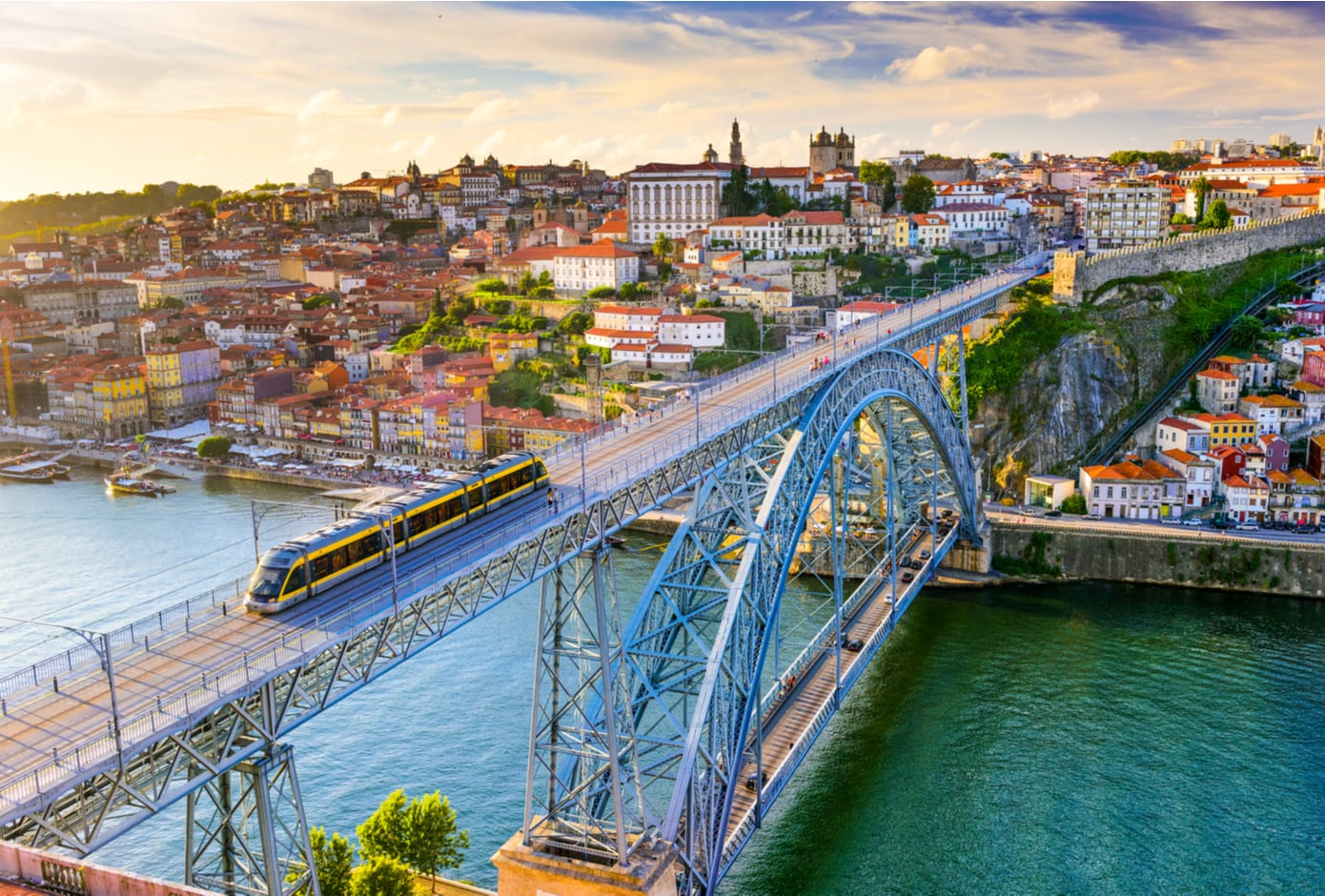
KEY INFO
| 📍 Address | Largo Aviz, 4430-329 Vila Nova de Gaia, Get Directions |
| 🚉 Getting There | Take bus from Lisbon Oriente to Mosteiro da Serra do Pilar, Largo Aviz. |
| 🤑 Ticket Price | Free to visit |
Overlooking the Douro River, the Historic Centre of Oporto is a UNESCO World Heritage Site, along with the postcard-worthy Luiz I Bridge and the Monastery of Serra do Pilar. Porto is certainly one of the most charming destinations in Portugal, and its city center is one of the oldest in Europe, with a 2,000-year history.
The city features a slew of well preserved architectural gems, which you can perfectly uncover while exploring the city on foot. During your errands, you’ll certainly come across stunning buildings erected over the past centuries. Make sure to visit the Romanesque-style Porto Cathedral —the city’s oldest surviving structure —, the Monument Church Of St Francis, the most important Gothic monument in Porto, and the Baroque-style Clérigos Tower.
Aside from historic religious buildings, the city also features three bridges, the most prominent being the Luiz I Bridge that spans the Douro River and connects Porto and Vila Nova de Gaia. When it was completed, in 18886, the bridge had the longest span of any metal bridge in the world.
To experience the best Porto has to offer, cross the Luiz I Bridge —just make sure to quickly stop on the bridge and check out the best view of the city — and go to Vila Nova de Gaia. Filled with world-class wine cellars, the city is also home to the Monastery of Serra do Pilar, the architectural landmark of Gaia. The former monastery was built between 1538 and 1670 and includes a church featuring carved gold leaf altars with Solomonic columns. Bonus? The monastery also has a viewpoint that offers one of the best panoramic views of the Douro and the center of Porto.
Find Hotels in Porto, Portugal | Find Homes in Porto, Portugal
Prehistoric Rock Art Sites in the Côa Valley and Siega Verde (1998,2010)
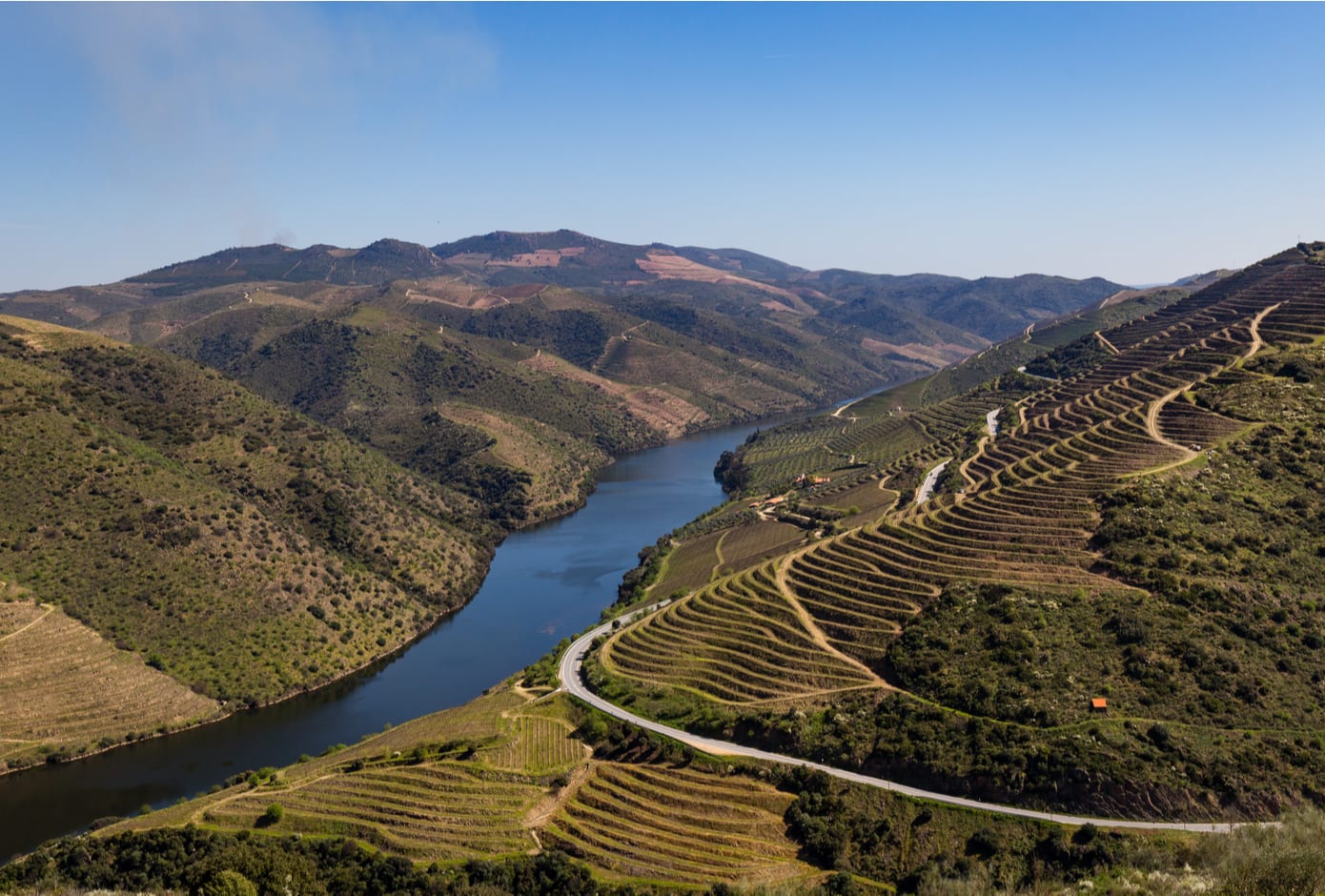
KEY INFO
| 📍 Address | R. do Museu, 5150-610 Vila Nova de Foz Côa, Get Directions |
| 🚉 Getting There | Take the car from Lisabon and drive via A23 or A1. |
| 🧭 Suggested Duration | 4-6 hours |
Located in northeastern Portugal, near the border with Spain, the Côa Valley Archaeological Park (PAVC) comprises, along with the Siega Verde Archaeological Park, in Spain, hundreds of prehistorical panels. Both the Côa Valley Park and the Siega Verde are placed on the banks of the rivers Agueda and Côa, which are tributaries of the Douro River, and display rock engravings that date from the Upper Paleolithic to the final Magdalenian/ Epipalaeolithic (22.000 – 8.000 BCE).
Managing a total area of 2 hundred square kilometers, the Côa Valley Park is an immense open air art gallery adorned not only with engravings from the Neolithic and the Chalcolithic but also from the Iron Age, as well as from the 17th, 18th, 19th, and 20th centuries.
There are three centers that can be visited in the Côa Park: Canada do Inferno, close to Vila Nova de Foz Côa, which are the first group of engravings to be discovered; Ribeira de Piscos, at Muxagata, and Penascosa, close to the village of Castelo Melhor.
Find Hotels Near Côa Valley, Portugal | Find Homes Near Côa Valley, Portugal
Laurissilva of Madeira (1999)
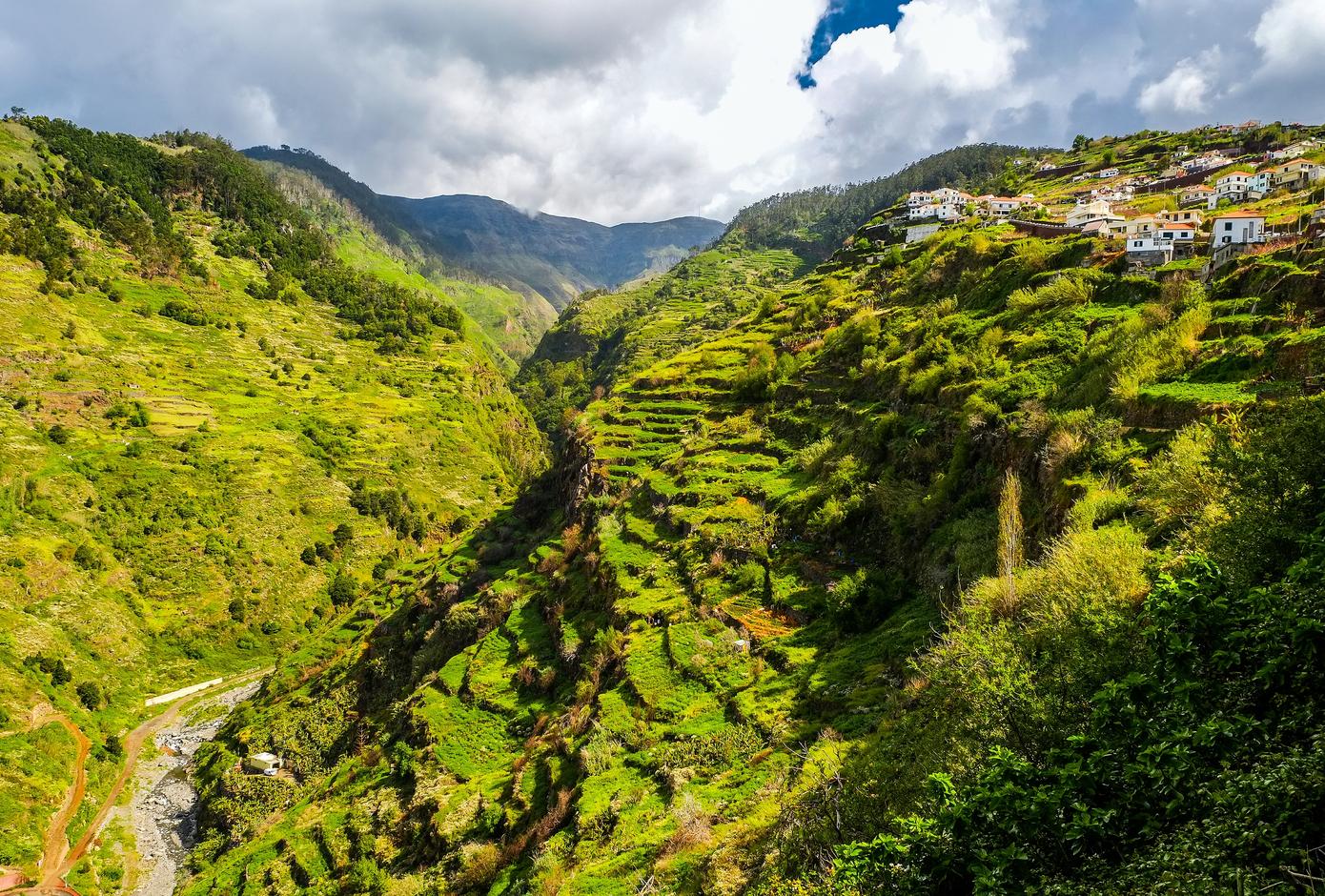
KEY INFO
| 📍 Address | Madeira Island, Get Directions |
| 🚉 Getting There | Take the car/taxi from Funchal to Laurisilva of Madeira. |
| 🧭 Suggested Duration | 4-6 hours |
The Laurisilva of Madeira is a green sanctuary located within the Madeira Natural Park. Covering 20% of the Island of Madeira, this is the largest surviving laurel forest in the world, and it houses a unique ensemble of native plants and animals, including endemic species that are only found within the forest.
Found in areas with high humidity and relatively stable, mild temperatures, the laurel forest is a type of subtropical forest that covered much of Southern Europe 15-40 million years ago. Due to the different glaciations in Europe, the “laurissilva” disappeared in a great part of Europe and, now, this lush forest is confined to the Azores, Canary Islands, and Madeira Island.
The Laurisilva of Madeira can be explored throughout a few trekking accessible areas and is a place of importance in Portugal thanks to its biological diversity. Aside from maintaining the hydrological balance on the island, and producing abundant sources of water used by the local people, the forest is home to about 760 plants. Of those, 149, including the Madeira Orchid, are edemic, which means that they grow only on the island.
Find Hotels in Madeira, Portugal | Find Homes in Madeira, Portugal
Historic Centre of Guimarães (2001)
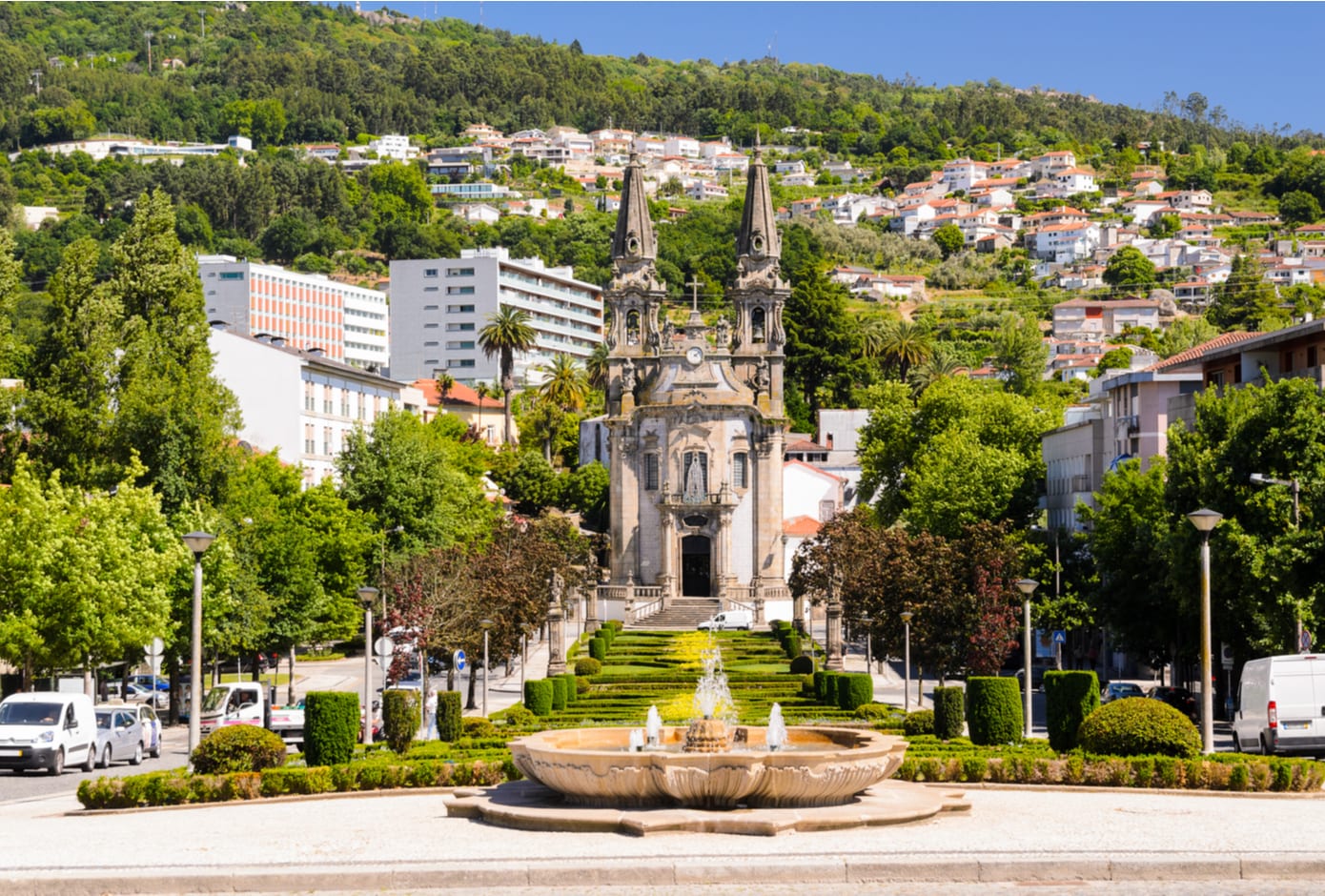
KEY INFO
| 📍 Address | Largo da Oliveira, 4810-431 Guimarães, Get Directions |
| 🚉 Getting There | Take the bus from Lisbon Sete Rios to the Historic Centre of Guimarães. |
| 🧭 Suggested Duration | 4-6 hours |
Placed in the district of Braga, Guimarães is a great day trip from Porto and the perfect pit-stop for those who are taking a road trip from the North to the South of Portugal. Founded in the 4th-century, Guimarães is often referred to as the”birthplace of Portugal” or “the cradle city”, as it was the feudal territory of the Portuguese Dukes who declared the independence of Portugal in the 12th century. The city was also the first capital of Portugal, and the Battle of São Mamede, which was the most important event for the foundation of Portugal, was fought near Guimarães.
Guimarães was elected European Capital of Culture in 2012, as it plays host to a sizzling cultural scene, with a profusion of buildings dating from the 10th, 13th, 14th,15th, and 19th centuries. Its compact historic center can be explored in one day, and worth-visiting monuments include the hilltop Guimarães Castle, which is believed to be the birthplace of Afonso Henriques, Portugal’s first king, and the Baroque-style Our Lady of Consolation Church.
Find Hotels in Guimarães, Portugal
Alto Douro Wine Region (2001)
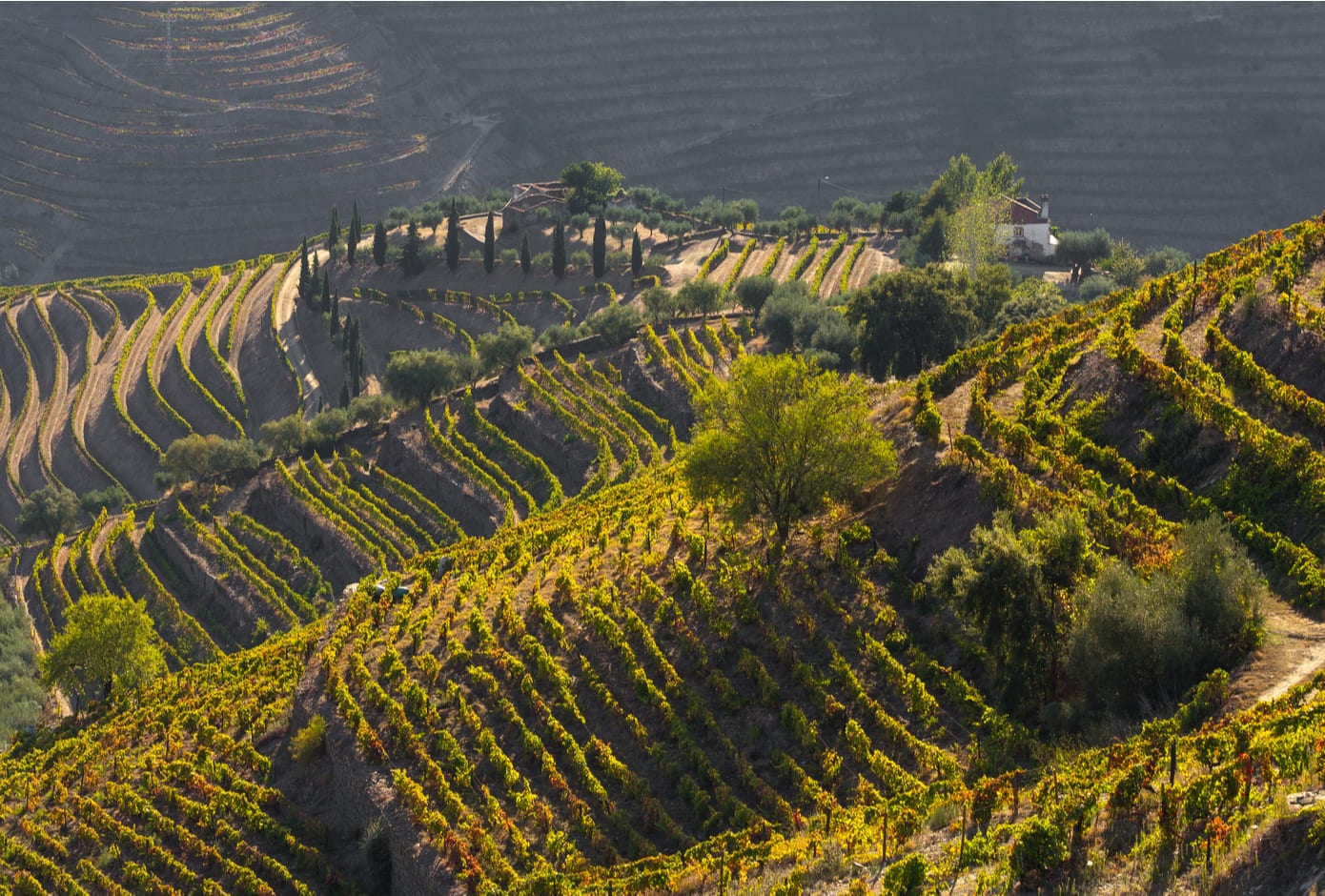
KEY INFO
| 📍 Address | Rua das Assoeiras, Lugar do Covo, 9001, 5050-405 Vinhós, Get Directions |
| 🚉 Getting There | Take the car from Lisbon to Alto Douro Wine Region via A1. |
| 🧭 Suggested Duration | 4-6 hours |
Portugal has many things to be proud of. It has 1,794 km of coastline dotted with idyllic beaches, amazing weather all year round, photogenic houses covered in ornamented tiles, and heartwarming food, just to name a few. But one of the country’s most praised staples is definitely the Port Wine. In fact, Portugal is home to the oldest viticultural legal region in the world, the Alto Douro Wine Region, which has been designated a World Heritage site in 2001.
Placed in the North of Portugal, the Alto Douro Wine Region has an ancient tradition of viticulture, and wine has been produced in the region for some 2,000 years. Since the 18th-century, the main product of the Douro Valley is the world-famous Port Wine, a fortified, rich, and smooth-on-the-palate wine that retains the natural sweetness of the grape.
The highly valuable cultural landscape of Alto Douro comprises terraced vineyards, wine-producing farm complexes, villages, slopes covered in schist walls, and deep valleys carved by the Douro River, which flows from central Spain to the city of Porto, in Portugal.
One of the best ways of exploring the great scenic beauty of the Alto Douro Wine Region is by taking the Port Wine Route. If you have time, opt for tracking the hillsides of Douro River’s course by car. Along the way, just make sure you stop at the local vineyards and wine cellars, where you’ll be able to learn about centuries-old wine tradition while sipping on some of the best wines in the world.
Find Hotels Near Alto Douro, Portugal | Find Homes Near Alto Douro, Portugal
The Landscape Of The Pico Island Vineyard Culture, Azores (2004)
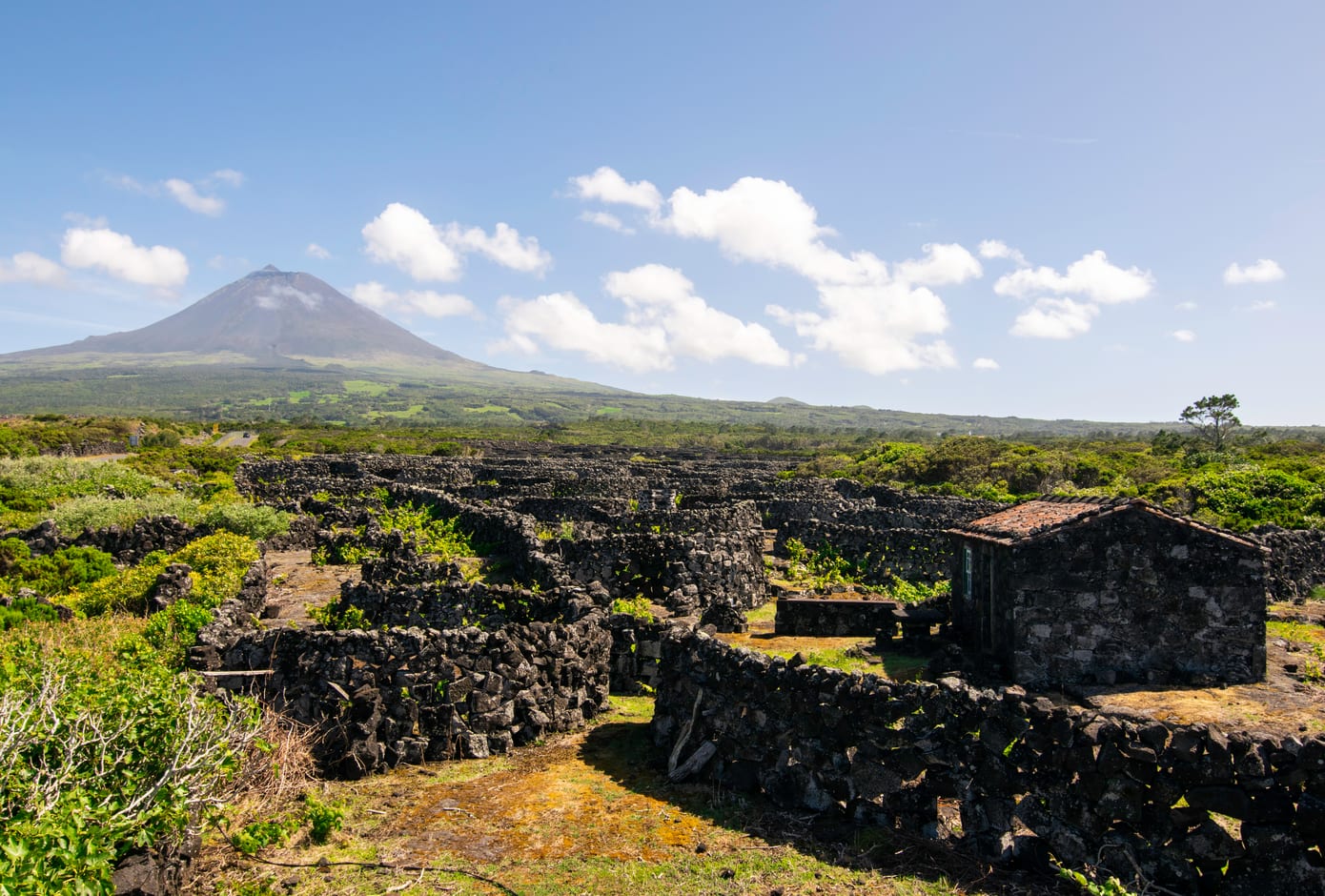
KEY INFO
| 📍 Address | Praca 25 de Abril, 2460-018, Alcobaça, Get Directions |
| 🚉 Getting There | Fly to Pico Island from major cities in Portugal, such as Lisbon or Porto, via SATA or TAP Portugal airlines. |
| 🧭 Suggested Stay | 1-3 days |
The Douro might be the most famous wine-growing area in Portugal, but the country harbors several other premium viniculture regions. The Pico Island Vineyard Culture, in the Azores archipelago, is one of them. There’s just one difference: in Pico Island, the vineyards are planted in black lava grounds.
Pico Island is the second-largest island of the Azores, and home to Mount Pico, a stratovolcano that is the highest mountain of Portugal, at 7,713 ft above sea level. Not by chance, the island is covered by extensive lava fields, which form the Landscape of the Pico Island Vineyard Culture, listed as a World Heritage by UNESCO in 2004. Spanning within 987 hectares of Pico Island, the picturesque Vineyard Culture is divided into small plots (called “Currais”), which are surrounded by stone walls, and separated from the other farms by larger walls, the “jeiros”.
Currently, in Pico Island, three noble indigenous varieties are grown: Arinto dos Açores, Verdelho, and Terrantez do Pico. These are white grape varieties are known for resulting in full-bodied and well-structured wines, with a complex aroma of spices.
One of the best places to go for a wine tasting on the Island is at the Cooperativa Vitivinícola da Ilha do Pico (CVIP), which offers a tour where you’ll have the opportunity not only to learn the history of the vineyards but also taste 6 nectars produced on the island Mountain.
Find Hotels in Pico Island Vineyard Culture, Portugal | Find Homes in Pico Island Vineyard Culture, Portugal
Garrison Border Town of Elvas and its Fortifications (2012)
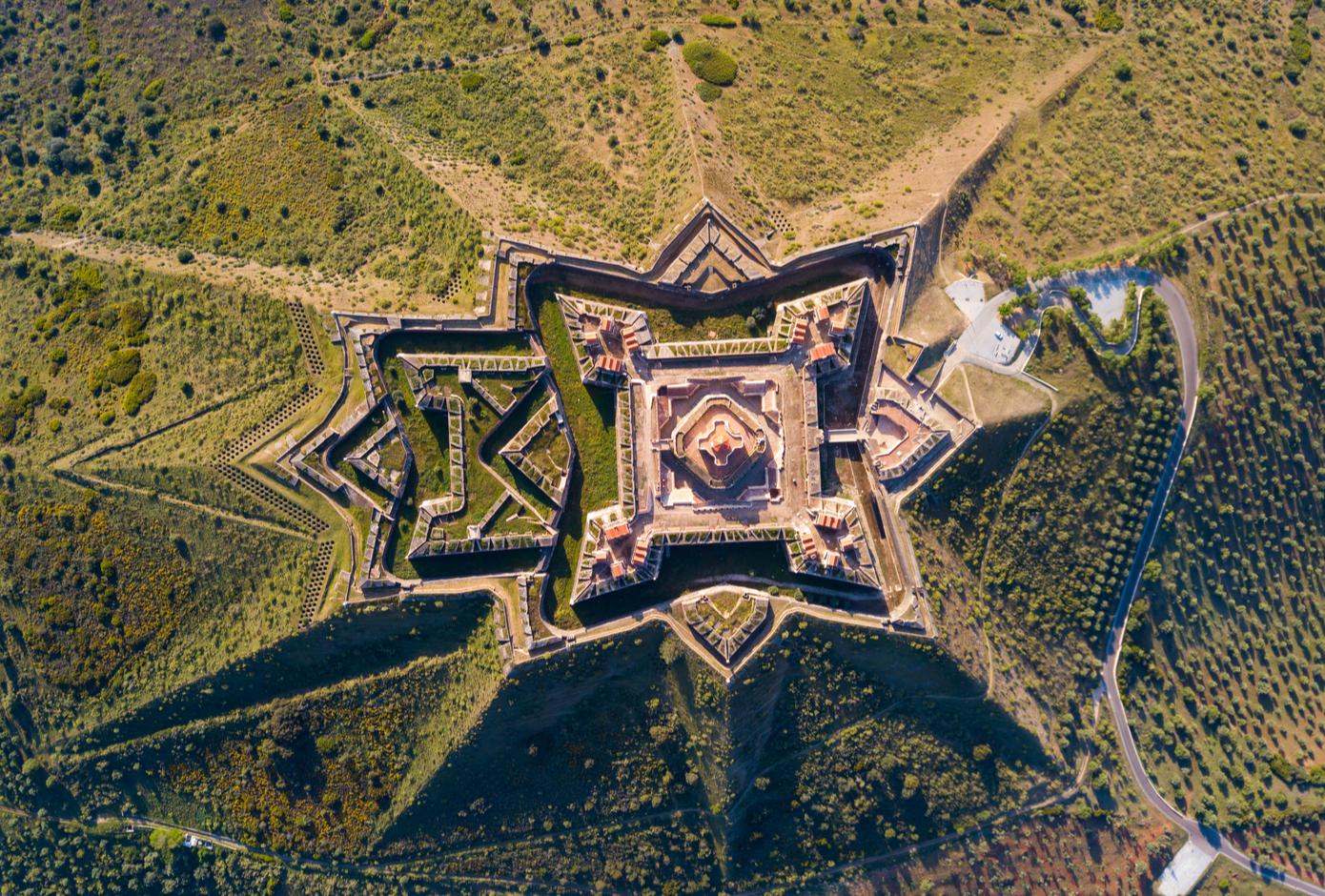
KEY INFO
| 📍 Address | Eastern Alentejo, Elvas 7350-133, Get Directions |
| 🚉 Getting There | Take the bus from Lisbon to Elvas. |
| 🧭 Suggested Duration | 1-2 hours |
Built from the 17th to the 19th century, the Garrison Border Town of Elvas and its Fortifications is the largest bulwarked dry-ditch system in the world. This a World Heritage Site located in the region of Alentejo, near the Portuguese-Spanish border, and has seven components: the Historic Centre of Elvas, the Amoreira Aqueduct, the Fort of Santa Luzia, the Fort of Graça, and the Fortlets of São Mamede, São Pedro, and São Domingos. One of the most fascinating is definitely the Fort of Graça, which sits on the top of a rugged hill and it’s surrounded by a star-shaped defense system.
The fortifications, carefully designed by the Dutch Jesuit Cosmanded and adapted to the irregular topography of Elvas, are the second World Heritage Site in Alentejo. A great idea is to go on a road trip in the region and explore the fascinating cities in south-central and southern Portugal. After Elvas, head over to Évora and then to Reguengos de Monsaraz, which was elected European wine capital in 2015.
Find Hotels in Elvas, Portugal
University of Coimbra – Alta and Sofia (2013)
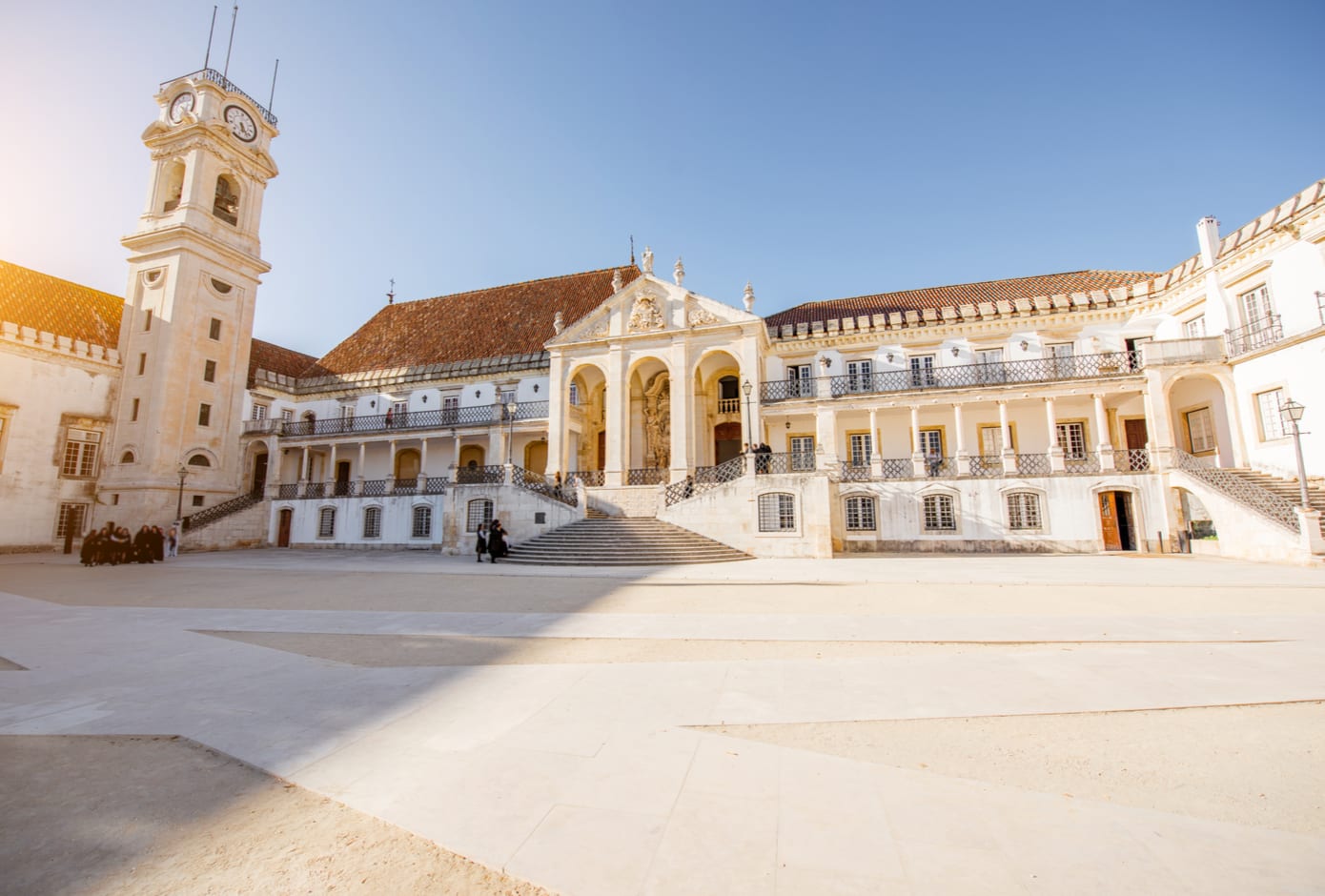
KEY INFO
| 📍 Address | Rua do Arco da Traicao, Coimbra 3000-056, Get Directions |
| 🚉 Getting There | Take the train from Oriente railway station to Coimbra. |
| 🧭 Suggested Duration | 4-6 hours |
The riverfront city of Coimbra also deserves a place on top of the bucket list for those who are going to Portugal. Built on the banks of the Mondego River, Coimbra is the country’s former capital, and it’s particularly famous for housing the historic the University of Coimbra, the oldest in Portugal, listed as a UNESCO Heritage Site in 2013.
Founded in Lisbon by Dom Dinis, in 1290, the University of Coimbra was permanently transferred to Coimbra in 1537. The university was established in the Royal Palace of Alcáçova, on the hill above the town (Alta), overlooking the Mondego River. Over the centuries, it developed into a series of colleges, but it managed to preserve its stunning features, including the Baroque-style Joanina Library, which houses more than 53 thousand books from the 16th to the 18th centuries.
Fun fact: some say that the black cloak worn by the students of the Coimbra University inspired J.K. Rowling when creating the iconic dress code of Hogwarts.
Find Hotels in Coimbra, Portugal
Royal Building of Mafra – Palace, Basilica, Convent, Cerco Garden and Hunting Park (2019)
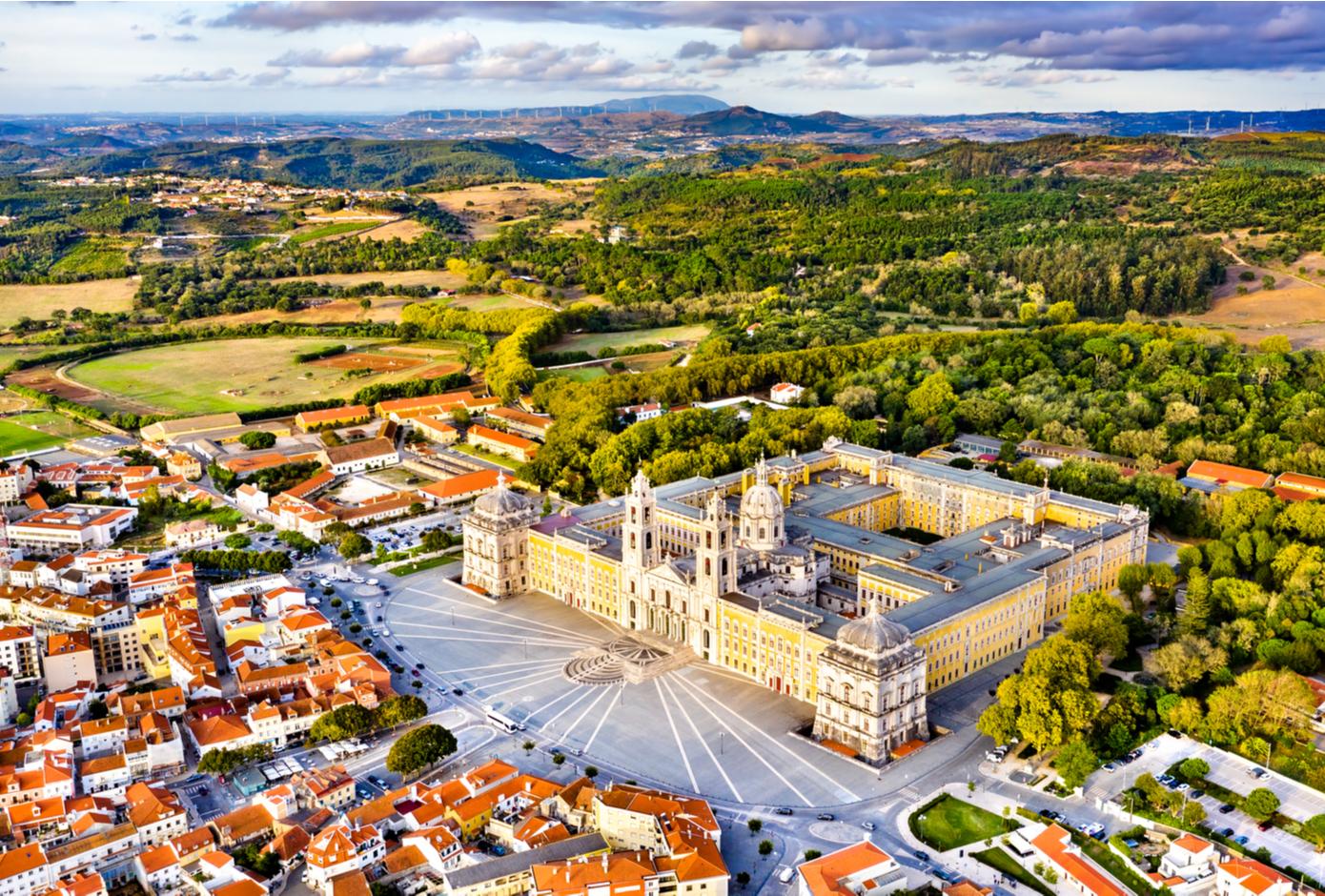
KEY INFO
| 📍 Address | Terreiro D. João V, Mafra, Portugal, Get Directions |
| 🚉 Getting There | Take the train from Campo Grande metro station in Lisbon to Cerco Garden. |
| 🧭 Suggested Duration | 2-3 hours |
After a full immersion in Lisbon, we recommend a day trip to Mafra, which is located only 40 minutes from the capital. The city is mostly known for the Royal Building of Mafra, which encompasses a Palace, a Basilica, a Convent, a Garden, and a Hunting Park (Tapada Nacional de Mafra). Designed by the German architect Johann Friedrich Ludwig, the Royal Building of Mafra was ordered by King John V in 1711, and it became not only a Baroque masterpiece but also a symbol of the king’s power.
One of the most notable features of the complex is the National Palace of Mafra, which was the summer residence of the royal family, and built thanks to the Brazilian gild that poured into the country. Covering an area of almost four hectares, the palace is the most important Baroque building in Portugal, and it’s home to 1.200 rooms, more than 4.700 doors and windows, 156 stairways, and 29 inner yards and courtyards. The largest and most prestigious room and the building is the National Library of Mafra, with wooden Rococo bookshelves that hold some 36,000 books dating from the 14th to the 19th centuries.
To gild the lily, pay a visit to the Basilica, which houses a set of six organs, altarpieces by the Italian artist Alessandro Giusti, and the most significant collection of baroque sculpture outside Italy.
Find Hotels in Mafra, Portugal | Find Homes in Mafra, Portugal
Sanctuary of Bom Jesus do Monte, Braga (2019)
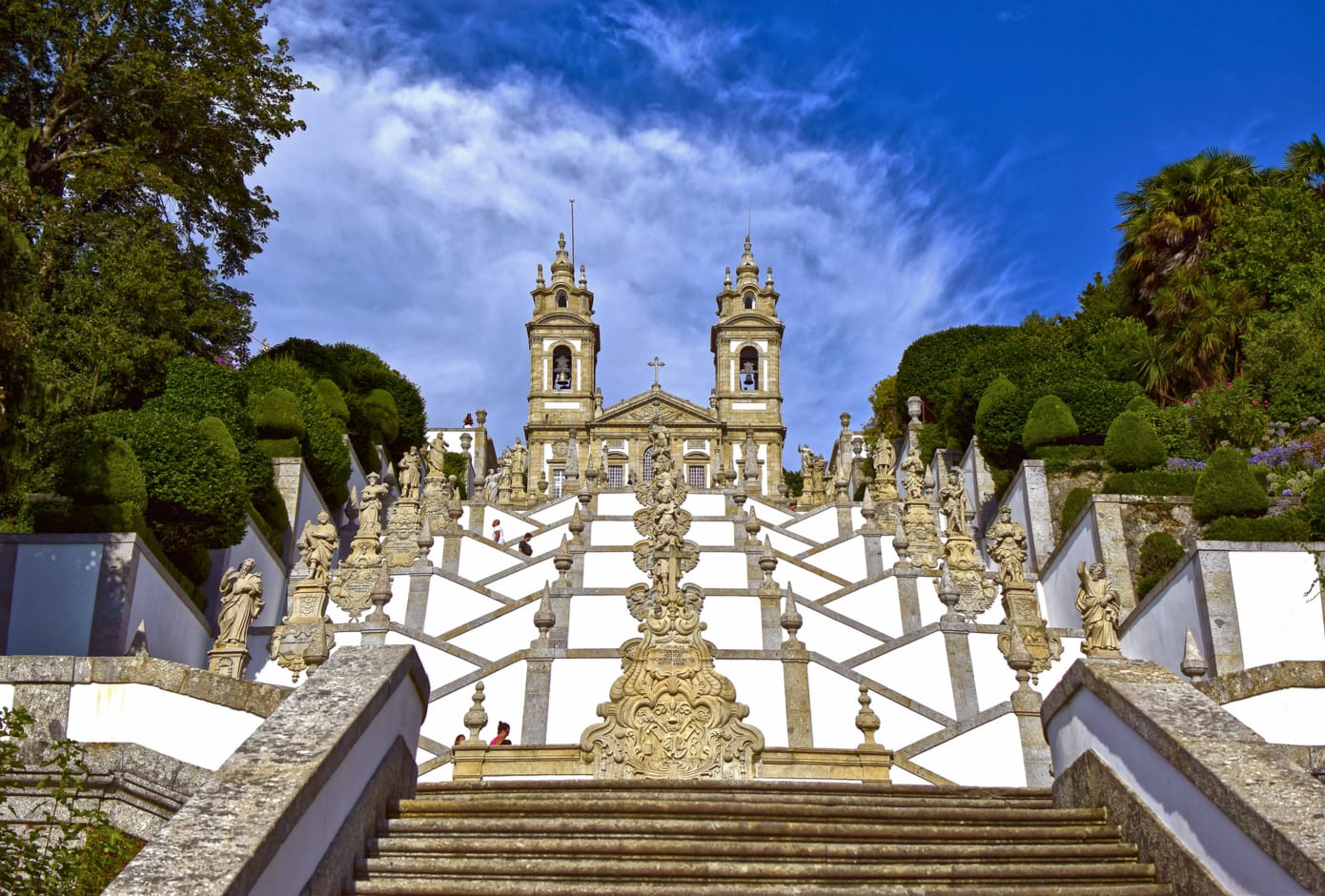
KEY INFO
| 📍 Address | Estrada do Bom Jesus, 4715-056 Tenões, Get Directions |
| 🚉 Getting There | Take the bus from Braga to Sanctuary of Bom Jesus do Monte. |
| 🧭 Suggested Duration | 2-3 hours |
A sculptured stairway with 573 steps leads to the top of a hill, where the Bom Jesus do Monte Church sits. Developed over more than 600 years, the staircase and the church form the Sanctuary of Bom Jesus do Monte, in Braga, which is surrounded by a densely wooded verdant area.
The stairway is adorned with symbolic fountains, statues, and Borque-style decorative elements, which represent the Stations of the Cross, the Five Senses, the Virtues, Moses receiving the Commandments and, at the top, the biblical figures that contributed to the Condemnation of Jesus.
Whether you choose to take the stairs or reach the top by funicular, make sure you take in the view from the bottom of the Stairway, where you’ll have a jaw-dropping view of the granite fountains placed on the various landings. Once you get to the top, you’ll be rewarded with another breathtaking view: the scenic landscape of the city of Braga, in the north of Portugal.
Find Hotels in Braga, Portugal | Find Homes in Braga, Portugal
Frequent Asked Questions
Are there any transnational UNESCO World Heritage Sites in Portugal?
Yes, the Prehistoric Rock Art Sites in the Côa Valley and Siega Verde is a transnational site shared with Spain, making it only transnational Heritage Site Protugal.
Why is Porto a World Heritage Site?
Porto is recognized as a UNESCO World Heritage Site primarily for its outstanding universal value as a historic city with a rich architectural and cultural heritage, including its well-preserved historic center, notable landmarks such as the Dom Luís I Bridge and the Ribeira district, and its significant contributions to European urban development and maritime trade history.
Which World Heritage Site in Portugal is considered a relic due to its natural beauty?
The Laurisilva of Madeira is considered a relic due to its mystical beauty and is Portugal’s only natural World Heritage Site, covering a significant portion of Madeira Island.
